Ionic currents in intimal cultured synoviocytes from the rabbit
- PMID: 20720182
- PMCID: PMC2980311
- DOI: 10.1152/ajpcell.00028.2010
Ionic currents in intimal cultured synoviocytes from the rabbit
Abstract
Hyaluronan, a joint lubricant and regulator of synovial fluid content, is secreted by fibroblast-like synoviocytes lining the joint cavity, and secretion is greatly stimulated by Ca(2+)-dependent protein kinase C. This study aimed to define synoviocyte membrane currents and channels that may influence synoviocyte Ca(2+) dynamics. Resting membrane potential ranged from -30 mV to -66 mV (mean -45 ± 8.60 mV, n = 40). Input resistance ranged from 0.54 GΩ to 2.6 GΩ (mean 1.28 ± 0.57 GΩ; ν = 33). Cell capacitance averaged 97.97 ± 5.93 pF. Voltage clamp using C(s+) pipette solution yielded a transient inward current that disappeared in Ca(2+)-free solutions and was blocked by 1 μM nifedipine, indicating an L-type calcium current. The current was increased fourfold by the calcium channel activator FPL 64176 (300 nM). Using K(+) pipette solution, depolarizing steps positive to -40 mV evoked an outward current that showed kinetics and voltage dependence of activation and inactivation typical of the delayed rectifier potassium current. This was blocked by the nonspecific delayed rectifier blocker 4-aminopyridine. The synoviocytes expressed mRNA for four Kv1 subtypes (Kv1.1, Kv1.4, Kv1.5, and Kv1.6). Correolide (1 μM), margatoxin (100 nM), and α-dendrotoxin block these Kv1 subtypes, and all of these drugs significantly reduced synoviocyte outward current. The current was blocked most effectively by 50 nM κ-dendrotoxin, which is specific for channels containing a Kv1.1 subunit, indicating that Kv1.1 is critical, either as a homomultimeric channel or as a component of a heteromultimeric Kv1 channel. When 50 nM κ-dendrotoxin was added to current-clamped synoviocytes, the cells depolarized by >20 mV and this was accompanied by an increase in intracellular calcium concentration. Similarly, depolarization of the cells with high external potassium solution caused an increase in intracellular calcium, and this effect was greatly reduced by 1 μM nifedipine. In conclusion, fibroblast-like synoviocytes cultured from the inner synovium of the rabbit exhibit voltage-dependent inward and outward currents, including Ca(2+) currents. They thus express ion channels regulating membrane Ca(2+) permeability and electrochemical gradient. Since Ca(2+)-dependent kinases are major regulators of synovial hyaluronan secretion, the synoviocyte ion channels are likely to be important in the regulation of hyaluronan secretion.
Figures










Similar articles
-
Characteristics of action potentials and their underlying outward currents in rat taste receptor cells.J Neurophysiol. 1996 Feb;75(2):820-31. doi: 10.1152/jn.1996.75.2.820. J Neurophysiol. 1996. PMID: 8714655
-
Heteromultimeric Kv1.2-Kv1.5 channels underlie 4-aminopyridine-sensitive delayed rectifier K(+) current of rabbit vascular myocytes.Circ Res. 2001 Nov 23;89(11):1038-44. doi: 10.1161/hh2301.100803. Circ Res. 2001. PMID: 11717161
-
Predominant expression of Kv1.3 voltage-gated K+ channel subunit in rat prostate cancer cell lines: electrophysiological, pharmacological and molecular characterisation.Pflugers Arch. 2003 Aug;446(5):559-71. doi: 10.1007/s00424-003-1077-0. Epub 2003 Jul 1. Pflugers Arch. 2003. PMID: 12838421
-
Why do platelets express K+ channels?Platelets. 2021 Oct 3;32(7):872-879. doi: 10.1080/09537104.2021.1904135. Epub 2021 Apr 19. Platelets. 2021. PMID: 33872124 Free PMC article. Review.
-
Regulation of ion channels by pyridine nucleotides.Circ Res. 2013 Feb 15;112(4):721-41. doi: 10.1161/CIRCRESAHA.111.247940. Circ Res. 2013. PMID: 23410881 Free PMC article. Review.
Cited by
-
Pro-inflammatory Cytokines Drive Deregulation of Potassium Channel Expression in Primary Synovial Fibroblasts.Front Physiol. 2020 Mar 24;11:226. doi: 10.3389/fphys.2020.00226. eCollection 2020. Front Physiol. 2020. PMID: 32265733 Free PMC article.
-
KCa1.1 inhibition attenuates fibroblast-like synoviocyte invasiveness and ameliorates disease in rat models of rheumatoid arthritis.Arthritis Rheumatol. 2015 Jan;67(1):96-106. doi: 10.1002/art.38883. Arthritis Rheumatol. 2015. PMID: 25252152 Free PMC article.
-
KCa1.1 potassium channels regulate key proinflammatory and invasive properties of fibroblast-like synoviocytes in rheumatoid arthritis.J Biol Chem. 2012 Feb 3;287(6):4014-22. doi: 10.1074/jbc.M111.312264. Epub 2011 Nov 10. J Biol Chem. 2012. PMID: 22074915 Free PMC article.
-
Adenosine monophosphate-activated protein kinase activation and suppression of inflammatory response by cell stretching in rabbit synovial fibroblasts.Mol Cell Biochem. 2016 Dec;423(1-2):175-185. doi: 10.1007/s11010-016-2835-6. Epub 2016 Sep 30. Mol Cell Biochem. 2016. PMID: 27686453
-
Differences in ion channel phenotype and function between humans and animal models.Front Biosci (Landmark Ed). 2018 Jan 1;23(1):43-64. doi: 10.2741/4581. Front Biosci (Landmark Ed). 2018. PMID: 28930537 Free PMC article. Review.
References
-
- Aune TM. Inhibition of arthritis by L-type calcium channel antagonists nimodipine, nisoldipine and nifedipine. US patent 5478848, 1995
-
- Bae YM, Kim A, Kim J, Park SW, Kim TK, Lee YR, Kim B, Cho SI. Serotonin depolarizes the membrane potential in rat mesenteric artery myocytes by decreasing voltage-gated K+ currents. Biochem Biophys Res Commun 347: 468–476, 2006 - PubMed
-
- Baumgarten L, Villereal M. Bradykinin stimulates Ca2+ entry via nitrendipine-sensitive Ca2+ channels in cultured human fibroblasts. Agents Actions Suppl 38: 1–8, 1992 - PubMed
Publication types
MeSH terms
Substances
Grants and funding
LinkOut - more resources
Full Text Sources
Research Materials
Miscellaneous

